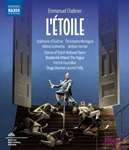|
Back
05/28/2019
Emmanuel Chabrier: L’Etoile
Stéphanie d’Oustrac (Lazuli), Christophe Mortagne (Le Roi Ouf Ier), Hélène Guilmette (Princesse Laoula), Jèrôme Varnier (Siroco), Elliot Madore (Hérisson de Porc-Epic), Julie Boulianna (Aloès), François Piolino (Tapioca), François Soons (Patacha), Harry Teeuwen (Zalzal), Jeroen van Glabbeek (Le Maître), Richard Prada (Chef de la police), Hrafnhildur Arnadóttir, Lilian Farahani, Zinzi Frohwein, Sidsel Aja Eriksen, Merlijn Runia, Chloë Schaaf (Les demoiselles d’honneur), Chorus of Dutch National Opera, Nicholas Jenkins (chorus master), Residentie Orkest The Hague, Patrick Fournillier (conductor), Laurent Pelly (stage director and costume designer), Jean-Jacques Delmotte (costume collaboration), Chantal Thomas (set designer), Joël Adam (lighting designer), François Roussillon (film director)
A co-production of Dutch National Opera, Amsterdam and François Roussillon et Associés with participation of France Télévisions, Mezzo and support of the Centre national du cinéma et de l’image animée
Recording: Dutch National Opera and Ballet, Amsterdam, The Netherlands (October 13 and 16, 2014) – 115’
Naxos 2.110595 (or Blu-ray NBD0091V) – NTSC 16:9 – PCM Stereo and DTS 5.0 – Region: 0 – DVD 9 - Booklet in English – Subtitles in French, English, German, Japanese and Korean

   
At the premier, L’Etoile, Emmanuel Chabrier’s first completed opera, was met with raised eyebrows by the orchestra due to the difficulty of the score...that shouldn’t come as any surprise. Despite the tortuous and lickety-split pathway this opéra bouffe takes, Laurent Pelly elucidates the rollicking gambol under a devilishly brilliant lens...there’s no weak link in this production. Each of the nearly dozen principals brings out the best in their character with the absurdity being buttressed by the Dutch National Opera Chorus and Patrick Fournillier’s meticulous control.
When sizing up to Chabrier’s later opéra-comique, Le Roi malgré lui, L’Etoile doesn’t exercise as many formally structured arias and duets, but the plotline is equally befogging, though not as overly-tedious. Disciplines in direction, costuming, set design and lighting aid in unraveling some of the question marks, and the overall presence glows with stellar incandescence.
Satirical at best, M. Pelly must have reflected upon Félix Régamey’s 1877 press cartoon to tailor Jérôme Varnier’s Siroco, a more expectant garb for the astrologer. Contrastingly, Christophe Mortagne’s Le Roi Ouf, adorned by an amusing petite couronne, looks more like an astringent Hercule Poirot pulled from a René Magritte gallery. Surrealism pops out everywhere, including warpy eye make-up (choral members) and discombobulated haircuts.
Having performed the lead role back in 2007 at the Opéra-Comique, Stéphanie d’Oustrac sojourns to Amsterdam to be the star female protagonist. Nowhere could there be a better match than having this mezzo-soprano fit into the trouser role of Lazuli, a sort of French Rossinian Figaro who nicely sets up her rambunctious tomboyish behavior during the opening “Je suis Lazuli.” François Roussillon’s camera cuts to close-ups of facial expressions sharply coincide with Chabrier’s deliberate notes, strongly turning to Laurent Pelly’s spunky 2012 Cendrillon in Lille, among others. An animaux dimension is repeated in L’Etoile, only this time including the antics of Beagles (in headgear) acting as Le Roi’s protectant retinue. Hysterical.
The red-headed Laoula (Hélène Guilmette) is the linchpin running between Lazuli and Le Roi Ouf with a beautiful execution of grace notes during her “Couplets de la rose”. Riding around in a black and white striped Renault, we see les quatre, featuring the comings and goings of Elliot Madore’s Hérisson, along with his neatly blonde-coiffed wife, Aloès (Julie Boulianne) and the quirky antics of François Piolino’s Tapioca. Of balderdash hilarity is the “tickling trio” and the “green chartreuse duet.”
To give a sense of style, much of Emmanuel Chabrier’s color is Offenbachian in nature with sparks of Charles Lecocq’s La Fille de Madame Angot. But it points more directly at Arthur Sullivan (particularly The Mikado) with dashes of Donizetti to boot. Chantal Thomas’ scenic designs have outlandish proportions by its own right that spark some truth about the opera’s twisted sobriety which are reflected inside M. Pelly’s glumly austere cloth (with exception of the pink powderpuffs, les demoiselles d’honneur.) Acts II and III seem to encumber a bit (likely due to an overabundance of dialogue.)
‘Whimsical charm with an outrageous behavior’. L’Etoile is sure to please...this is an apex moment in operatic theater. Laurent Pelly is, again, to be lauded to the fullest by reaching for and achieving that one star.
Christie Grimstad
|